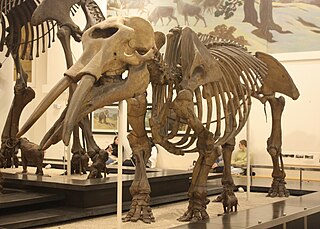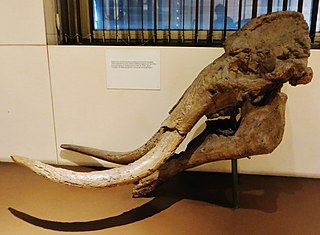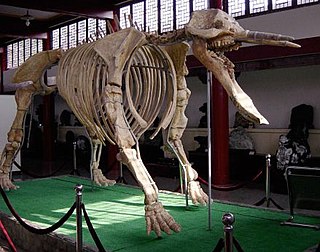
Proboscidea is a taxonomic order of afrotherian mammals containing one living family (Elephantidae) and several extinct families. First described by J. Illiger in 1811, it encompasses the elephants and their close relatives. Three species of elephant are currently recognised: the African bush elephant, the African forest elephant, and the Asian elephant.

A mastodon is a member of the genus Mammut, which, strictly defined, was endemic to North America and lived from the late Miocene to the early Holocene. Mastodons belong to the order Proboscidea, the same order as elephants and mammoths. Mammut is the type genus of the extinct family Mammutidae, which diverged from the ancestors of modern elephants at least 27-25 million years ago, during the Oligocene.

Mammutidae is an extinct family of proboscideans belonging to Elephantimorpha. It is best known for the mastodons, which inhabited North America from the Late Miocene until their extinction at beginning of the Holocene, around 11,000 years ago. The earliest fossils of the group are known from the Late Oligocene of Africa, around 24 million years ago, and fossils of the group have also been found across Eurasia. The name "mastodon" derives from Greek, μαστός "nipple" and ὀδούς "tooth", referring to their characteristic teeth.

Gomphotheres are an extinct group of proboscideans related to modern elephants. They were widespread across Africa Eurasia and North America during the Miocene and Pliocene epochs and dispersed into South America during the Pleistocene as part of the Great American Interchange. Gomphotheres are a paraphyletic group that is ancestral to Elephantidae, which contains modern elephants, as well as Stegodontidae. While most famous forms such as Gomphotherium had long lower jaws with tusks, which is the ancestral condition for the group, some later members developed shortened (brevirostrine) lower jaws with either vestigial or no lower tusks, looking very similar to modern elephants, an example of parallel evolution, which outlasted the long-jawed gomphotheres. By the end of the Early Pleistocene, gomphotheres became extinct in Afro-Eurasia, with the last two genera, Cuvieronius ranging from southern North America to western South America, and Notiomastodon having a wide range over most of South America until the end of the Pleistocene around 12,000 years ago, when they became extinct following the arrival of humans.

Gomphotherium is an extinct genus of gomphothere proboscidean from the Neogene of Eurasia, Africa and North America. It is the most diverse genus of gompothere, with over a dozen valid species. The genus is probably paraphyletic.

Anancus is an extinct genus of "tetralophodont gomphothere" native to Afro-Eurasia, that lived from the Tortonian stage of the late Miocene until its extinction during the Early Pleistocene, roughly from 8.5–2 million years ago.

Stegomastodon is an extinct genus of gomphotheres. It ranged throughout North America from the Pliocene, to the Early Pleistocene. The former South American species have been synonymized with Notiomastodon platensis.

Sinomastodon is an extinct gomphothere genus known from the Late Miocene to Early Pleistocene of Asia, including China, Japan, Thailand, Myanmar, Indonesia and probably Kashmir.

Tetralophodon is an extinct genus of "tetralophodont gomphothere" belonging to the superfamily Elephantoidea, known from the Miocene of Afro-Eurasia.

Rhynchotherium is an extinct genus of proboscidea endemic to North America and Central America during the Miocene through Pliocene from 13.650 to 3.6 Ma, living for approximately 10 million years.
Gnathabelodon is an extinct genus of gomphothere endemic to North America that includes species that lived during the Middle to Late Miocene.

Eubelodon is an extinct genus of gomphothere which lived in North America during the Miocene Epoch. It contains a single species: Eubelodon morrilli.

Notiomastodon is an extinct genus of gomphothere proboscidean, endemic to South America from the Pleistocene to the beginning of the Holocene. Notiomastodon specimens reached a size similar to that of the modern Asian elephant, with a body mass of 3-4 tonnes. Like other brevirostrine gomphotheres such as Cuvieronius and Stegomastodon, Notiomastodon had a shortened lower jaw and lacked lower tusks, unlike more primitive gomphotheres like Gomphotherium.

Choerolophodon is an extinct genus of proboscidean that lived during the Miocene of Eurasia and Africa. Fossils of Choerolophodon have been found in Africa, Southeast Europe, Turkey, Iraq, Iran, the Indian subcontinent, and China.
Surameryx is an extinct genus of herbivorous artiodactyls originally described as belonging to the extinct family Palaeomerycidae. A single species, S. acrensis, was described from the Late Miocene of the Madre de Dios Formation, South America. It was originally interpreted as one of the few northern mammals that entered South America before the Pliocene. However, both its identification as a member of the family Palaeomerycidae and claims about its Miocene age were subsequently challenged.

Elephantimorpha is a clade of proboscideans that contains the Mammutidae (mastodons), as well as Elephantida. All members of this group have the horizontal tooth replacement typical of modern elephants, unlike more primitive members of the Elephantiformes. Like modern elephants, the ancestor of Elephantimorpha was likely capable of communicating via infrasonic calls. While early elephantimorphs generally had lower jaws with an elongated mandibular symphysis at the front of the jaw with well developed lower tusks/incisors, from the Late Miocene onwards, many groups convergently developed brevirostrine (shortened) lower jaws with vestigial or no lower tusks, corresponding with the elongation and increasingly dexterity of the trunk allowing it to be used as the primary feeding organ.

Amebelodontidae is an extinct family of large herbivorous proboscidean mammals related to elephants. They were formerly assigned to Gomphotheriidae, but recent authors consider them a distinct family. They are distinguished from other proboscideans by having flattened lower tusks and very elongate mandibular symphysis. The lower tusks could grow considerable size, with those of Konobelodon reaching 1.61 metres (5.3 ft) in length. Their molar teeth are typically trilophodont, and possessed posttrite conules. In the past, amebelodonts' shovel-like mandibular tusks led to them being portrayed scooping up water plants, however, dental microwear suggests that they were browsers and mixed feeders. The lower tusks have been proposed to have had a variety of functions depending on the species, including stripping bark, cutting through vegetation, as well as possibly digging. They first appeared in Africa during the Early Miocene, and subsequently dispersed into Eurasia and then North America. They became extinct by the beginning of the Pliocene. While some phylogenetic studies have recovered Amebelodontidae as a monophyletic group that forms the sister group to Gomphotheriidae proper, some authors have argued that Amebelodontidae may be polyphyletic, with it being suggested that the shovel-tusked condition arose several times independently within Gomphotheriidae, thus rendering the family invalid.
Eurybelodon is an extinct genus of proboscidean in the family Amebelodontidae. It lived in the Clarendonian age of the Miocene.

The research history of Mammut is extensive given its complicated taxonomic and non-taxonomic histories, with the earliest recorded fossil finds dating back to 1705 in Claverack, New York during the colonial era of what is now the United States of America. Initially thought to belong to biblical antediluvian giants, the fossils were later determined to belong to a proboscidean species as a result of more complete 18th century finds from the locality of Big Bone Lick in what is now Kentucky. The molars were studied by European and American naturalists, who were generally baffled on its lack of analogue to modern elephants, leading to varying hypothesis on the affinities of the teeth. More complete skeletons were found after the independence of the United States colonies from Great Britain within the early 19th century. American historians of the 21st century have made arguments that the early history of M. americanum finds and studies played major roles in shaping American nationalism on the basis of the large sizes and relative completeness of the fossils to disprove the negative theory of social degeneracy in North America.






















